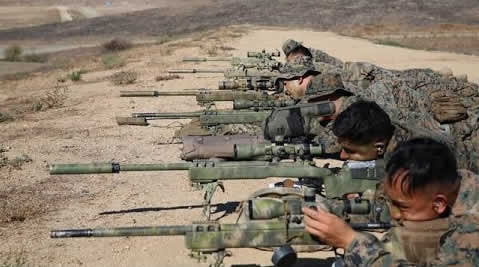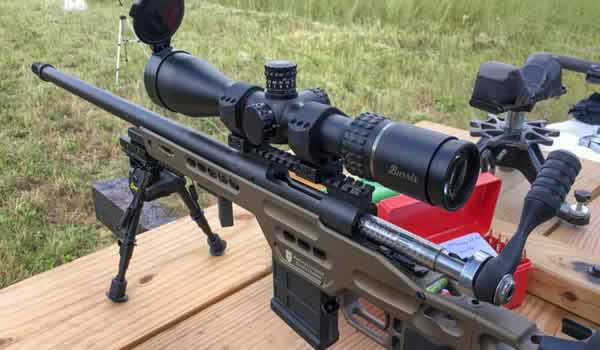
The Ins And Outs Of Precision
[su_heading size=”30″ margin=”0″]Exclusive Interview: Frank Green Of Bartlein Barrels[/su_heading]
INTERVIEW BY STEVE JOSEPH • PHOTOGRAPHS BY FRANK GREEN
If you have ever thought of getting involved in precision shooting, or are already immersed in the Precision Rifle Series competition, Bartlein Barrels is an industry name to know. Frank Green, Tracy Bartlein and Andy Kihn, who all previously worked for Kreiger Barrels, founded Bartlein Barrels and built it into what many are familiar with today – and for good reason.
Green sat down and gave us the ins and outs (pun intended) of their process and concepts of what makes them one of the best in the industry.
American Shooting Journal Who are the people behind Bartlein Barrels?
Frank Green We are experienced shooters, reloaders and hunters who have been working in the firearms industry collectively for over 30 years.
ASJ What is your title and tell us more about your background?
FG My title depends on which hat I’m wearing at the time. For the most part, I would say sales and technical service manager. I also do research and development for gun manufacturers, and rifle testing.

ASJ How did Bartlein get involved in the PRS?
FG Well, GA Precision-built rifles are used in the PRS more than any other builder, and GAP is one of our top customers. Also, other customers like Wade Stuteville at Stuteville Precision, who used to be one of the lead guys at Surgeon Rifles, Surgeon Rifles, Accuracy International, Dave Tooley, Marc Soulie at Spartan Rifles, Mark Gordon at Short Action Customs and several other makers use our barrels, and not just in PRS. You can find our barrels in short- and long-range benchrest, F-Class and Palma matches, high-power rifle matches and many others. A lot of people say that we are the go-to barrel maker. Becoming involved in the PRS just happened naturally.
ASJ Why would someone choose your barrels over another maker in the industry?
FG The uniformity in our barrels and bore finishes are second to none. Our rifling machines are so accurate that we can carry the twist rate to the fourth decimal point (example: 11.3642). The process of single-point cut rifling is the most stress-free way to rifle a barrel. The twist is exact. Other forms of rifling can have variances due to the process they use. Also, the bore and groove dimensions are more uniform.
We pre-lap (a smoothing process) our barrels before rifling and finish-lap the barrel after rifling. There is no need to fire-lap or conduct any other sort of bore polishing to the barrel. Contrary to what others say, a lapped barrel will not wear out earlier versus an unlapped one. In our experience, our barrels will typically last longer than a button barrel. Our desire is to make the best and be the best.

ASJ What types of barrels do you offer?
FG We offer chrome-moly steel (CM 4140) and stainless steel (SS 416R).
ASJ Which steel do you think is better?
FG Neither, from what we can see. If we had to pick one, we would lean towards the chrome-moly, possibly because it lasts longer, but how long a barrel lasts is subject to many variables: type of powder being used; how it is being shot and cleaned; types of bullets being shot, etc.
ASJ People often ask what “T-style” rifling is. Can you explain that?
FG We call it transitional rifling, but some refer to it as either gain twist, progressive twist or incremental twist. We can cut virtually any twist into a barrel, subject to tooling, of course, and we can start the twist at 1 in 14 and end up at 1 in 7, and have it uniformly increase from the breech to muzzle. We can also increase it very slowly, say, from 1 in 7.5 at the breech to a 1 in 7 at the muzzle.
“A cut barrel, even with a straight twist, is more uniform and consistent than a button barrel”
ASJ What are the benefits of the transition-style rifling?
FG I’ll quote a great bygone-era barrel maker named Pope:
“The advantages of the gain twist are three: A) A lower twist rate at the breech gives less friction to the bullet, causing it to start easier and quicker, giving the powder less time to burn in front of the chamber, therefore less fouling than in a barrel with a uniform twist at the same muzzle pitch; B) The slight change in rifling angle, in connection with choke bore, effectively shuts off any gas escaping and prevents gas cutting, which is another cause of imperfect delivery; C) It holds a muzzle-loaded bullet in position much better than a uniform twist.
I will add some more to this. First, I feel this applies more to a lead-bullet shooter than a jacketed-bullet shooter, but some of the why and why-nots do overlap. With a transition-style barrel the bullet cannot go to sleep. The rifling is always putting a fresh bite on the bullet as it goes down the bore of the barrel. This is why I always go back to a cut barrel being better than a button barrel.
A cut barrel, even with a straight twist, is more uniform and consistent than a button barrel. With button rifling, the button can hit a hard or soft spot in the steel, and it will slow the button down. The button could speed back up and complete its twist, but either way you end up with a non-uniform twist. This and a twist that keeps getting slower towards the muzzle are accuracy killers and consistently lead to problems such as fliers. Even a slight gain in twist will help accuracy and not hurt a jacketed bullet. What has been conveyed to us – and this goes back to Pope’s first point – is that shooters have noticed that they can run a slightly heavier powder charge versus a shooter with a straight twist barrel.
“More damage is done from cleaning than physically shooting the gun”
ASJ There are a lot of different schools of thought on cleaners, and what types to use. What do you recommend?
FG We do not recommend things like Iosso bore paste. The paste cleaners get imbedded into the bore, so the next rounds fired through the barrel will damage the bore. There is no way to be sure you have removed it completely from the barrel after cleaning, and some shooters have claimed that their barrel starts fouling right after use. We feel so strongly about this that we will not warranty any barrel cleaned with it. If you want to use a paste-type cleaner, we recommend Remington bore cleaner or JB.

ASJ What about cleaning brushes, do you recommend using them?
FG We only recommend using cleaning patches and solvent. If a shooter insists on using a brush, then we recommend one caliber smaller or an old worn-out one. Wrap a patch around the brush and push it breech to muzzle, unscrew the brush before pulling the cleaning rod back through the bore or over the crown. More damage is done from cleaning than physically shooting the gun.
ASJ Many shooters don’t even clean their rifles, and swear by this. What do you think?
FG I shoot them, I clean them, and the biggest reason is carbon fouling. The carbon fouling will keep building up and can cause pressure issues. Also, as the barrel wears over time, it won’t hold accuracy as long between strings of firing. So you have to clean the barrel. I do not recommend not cleaning at all.
ASJ Frank, thank you for taking the time to talk to us today. Your knowledge and expertise are greatly appreciated.
FG My pleasure. Thank you. ASJ
Related Posts

Bridging the Gap between a Sniper and Olympic Shooter

Snipers on their Job

